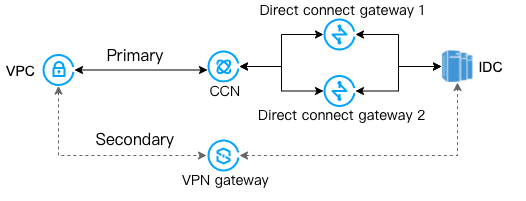概述
最后更新时间:2024-01-24 18:10:40
路由表由多条路由策略组成,用于控制私有网络内子网的出流量走向。每个子网只能关联一个路由表,一个路由表可以关联多个子网。您可以创建多个路由表,为不同流量走向的子网关联不同的路由表。
类型
路由表有默认路由表和自定义路由表两种类型:
默认路由表:用户创建私有网络时,系统会自动为其生成一个默认路由表。在之后的子网创建过程中,如果用户没有选择自定义路由表,子网会自动关联该默认路由表。您可以在默认路由表中添加、删除和修改路由策略,但无法删除该默认路由表。
自定义路由表:您可以在私有网络中创建自定义路由表,自定义路由表可以被删除。您可以为具有相同路由策略的子网建立一个自定义路由表,并将路由表与需要遵循其路由策略的所有子网关联。
路由策略
路由表通过路由策略来实现流量走向控制,路由策略由目的端、下一跳类型和下一跳组成:
目的端:目的端即为您要转发到的目标网段。目的网段描述仅支持网段格式,如果您希望目的端为单个 IP,可设置掩码为
32(如172.16.1.1/32)。另外,目的端不能为路由表所在私有网络内的 IP 段,原因是 Local 路由已表示此私有网络内默认内网互通。说明:
如容器网络和 VPC 已有路由重叠时,则优先在容器网络内转发。
下一跳类型:私有网络的数据包的出口。私有网络下一跳类型支持 “NAT 网关”、“对等连接”、“VPN 网关”、“专线网关”、“云服务器”等类型。
下一跳:指定具体跳转到的下一跳实例(使用下一跳 ID 标识),如私有网络内的某个具体 NAT 网关。
路由策略优先级
当路由表中存在多条路由策略时,路由优先级由高至低分别为:
私有网络内流量:私有网络内流量最优先匹配。
最精确路由(最长前缀匹配):当路由表中有多条条目可以匹配目的 IP 时,采用掩码最长(最精确)的一条路由作为匹配项并确定下一跳。
公网 IP:路由策略均匹配失效时,通过公网 IP 对 Internet 进行外访。
场景举例:
当一个子网关联了 NAT 网关,且子网内云服务器有公网 IP(或弹性公网 IP)时,会默认通过 NAT 网关访问 Internet(因为最精确路由的优先级高于公网 IP),但您可以设置路由策略,实现通过云服务器公网 IP 访问 Internet,详情请参见 调整 NAT 网关和 EIP 的优先级。
等价路由
等价路由 ECMP(Equal-CostMultipathRouting),是指到达同一目的地址存在多条相同代价的不同路径。在数据包传输时,如果使用传统的路由技术,去往同一目的地址的数据包仅能利用其中一条路径,而其他路径处于备份或者无效状态,当一条路径故障时,切换路径也需要耗费一定的时间,而等价路由可以在网络环境下同时使用多条路径,不仅增加了传输带宽,也实现了多路径流量负载均衡和冗余链路备份的目的。
VPC 同类型路由形成 ECMP 的情况如下:
下一跳类型 | 是否支持同类型形成 ECMP | ECMP 支持的最大数量 |
NAT 网关 | 是 | N/A |
云服务器公网 IP | 否 | N/A |
云服务器 | 是 | 同类型最多8个 |
对等连接 | 否 | N/A |
专线网关 | 否 | N/A |
云联网 | 否 | N/A |
高可用虚拟 IP | 是 | 同类型最多8个 |
VPN 网关 | 是 | 同类型最多8个 |
VPC 不同类型路由形成 ECMP 的情况如下:
NAT 网关和云服务器可形成 ECMP。
如已有自学习的云联网路由,当新增配置到专线网关/对等连接的自定义路由时,云联网与专线网关/对等连接可形成 ECMP。
如已有专线网关/对等连接的自定义路由,当加入云联网,且希望和云联网形成 ECMP 时,请 提交工单。
应用场景
等价路由通常用于:当网关承载带宽有限时,可通过路由实现网关间的流量负载。例如某用户在云上 VPC 和云下 IDC 业务通信带宽需要2000Mbps,但目前 VPN 带宽最大为1000Mbps,那么可以创建两个1000Mbps规格的 VPN 网关,建立两条 VPN 隧道来实现流量分担,两条 VPN 链路可以满足总带宽达到2000Mbps的需求。
主备路由
主备路由是指去往同一目的地址配置了2条或多条路径,而只有1条路径处于活跃状态,其他路径则处于备用或无效状态。例如 VPC 去往某 IDC 配置了两条路由,即路径 A 和路径 B,数据包仅通过主路径 A 去往目的地址,路径 B 处于无效备用状态;当路径 A 发生链路故障时,可使能路径 B 生效,流量则从路径 A 切到路径 B,保证了业务的可用性,这种情况下称路径 A、B 为主备路由。
VPC 路由表在添加路由策略时,根据下一跳类型定义了不同的优先级,即去往同一目的端,可以配置下一跳为不同类型的网关,形成主备路由,再结合 VPC 网络探测功能,探测链路质量和可达性,通过配置告警及时发现链路异常,快速切换主备路由,以满足业务高可用。
说明:
VPC 默认没有路由优先级功能,该功能目前处于内测中,如需使用,请提交工单。
VPC 路由表中根据不同的下一跳类型定义了不同的优先级,目前默认路由优先级为:云联网 > 专线网关 > VPN 网关 > 其他。
暂不支持控制台修改优先级,如需调整,请提交工单。
VPC 不同类型路由支持主备情况如下:
下一跳类型 | 是否支持主备 |
NAT 网关 | 否 |
云服务器公网 IP | 否 |
云服务器 | 是,支持与云联网/VPN 网关/专线网关/高可用虚拟 IP 形成主备 |
对等连接(同地域) | 否 |
对等连接(跨地域) | 否 |
专线网关 | 是,支持与云联网/VPN 网关/高可用虚拟 IP/云服务器形成主备 |
云联网 | 是,支持与 VPN/专线网关/高可用虚拟 IP/云服务器形成主备 |
高可用虚拟 IP | 是,支持与云联网/VPN 网关/专线网关/云服务器形成主备 |
VPN 网关 | 是,支持与云联网/专线网关/高可用虚拟 IP/云服务器形成主备 |
应用场景
主备路由通常用于:当某一网关链路故障时,可通过主备路由实现流量的平滑切换。例如:
VPC 型专线网关(主)& VPC 型 VPN 网关(备)
场景描述:用户通过 VPC 型专线网关打通云上 VPC 和自建 IDC 的通信,同时通过 VPN 网关创建 VPN 备用通道来实现 IDC 与 VPC 通信链路的备份。

云联网型专线网关(主)& VPC 型 VPN 网关(备)
场景描述:用户通过云联网型专线网关打通云上 VPC 和自建 IDC 的通信,同时通过 VPN 网关创建 VPN 备用通道来实现 IDC 与 VPC 通信链路的备份。

文档反馈

